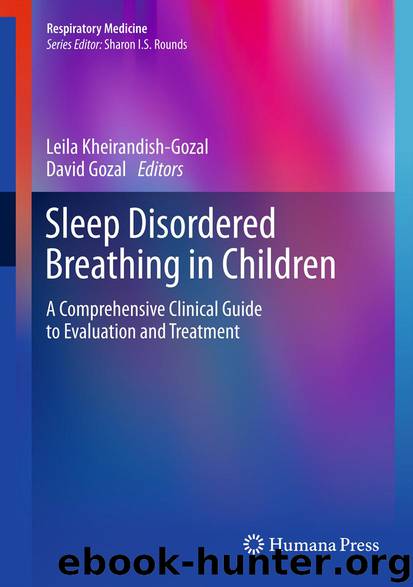Sleep Disordered Breathing in Children by Leila Kheirandish-Gozal & David Gozal

Author:Leila Kheirandish-Gozal & David Gozal
Language: eng
Format: epub
Publisher: Humana Press, Totowa, NJ
Prenatal and Perinatal Stress, Obesity, and Sleep-Disordered Breathing
It has been shown that prenatal and perinatal stress may lead to insulin resistance and metabolic syndrome. We investigated the association of SDB with a wide range of risk factors, including prenatal and perinatal complications, the association of these complications with SES and race, and the association of SDB with developmental milestones [60]. Six hundred thirteen school-aged children (105 clinically referred and 508 community controls) underwent an overnight polysomnography and complete history and physical examination. A comprehensive child development questionnaire was completed by a parent. We compared clinically referred children with SDB to population-based control children without SDB from the Penn State Child Cohort. Maternal smoking during pregnancy, maternal age and weight gain during pregnancy, prenatal complications such as maternal high blood pressure and gestational diabetes, perinatal complications related to prematurity, delayed motor milestones, race, and socioeconomic status were significantly associated with the presence of childhood SDB. Most of the risk factors became nonsignificant when analyses controlled for race and SES. Delayed motor milestones remained significantly associated with SDB after controlling for race and SES.
It is becoming increasingly clear that the mechanisms underlying SDB in children are multiple and include individual genetic susceptibility; anatomic, metabolic, and sociodemographic factors; and pre-perinatal complications (Fig. 21.4). We propose that pre-perinatal distress may lead to development of childhood SDB in two possible ways. The first is by affecting metabolic pathways, i.e., weight, and glucose control which in turn may lead to the development of childhood SDB. The second is by inducing neurologic (CNS) insult, as evidenced by the significant delay in motor milestones, which could influence the neural mechanisms of respiration [60].
Fig. 21.4Hypothetical model of the additive risk factors for childhood SDB
Download
This site does not store any files on its server. We only index and link to content provided by other sites. Please contact the content providers to delete copyright contents if any and email us, we'll remove relevant links or contents immediately.
When Breath Becomes Air by Paul Kalanithi(7264)
Why We Sleep: Unlocking the Power of Sleep and Dreams by Matthew Walker(5642)
Paper Towns by Green John(4169)
The Immortal Life of Henrietta Lacks by Rebecca Skloot(3826)
The Sports Rules Book by Human Kinetics(3588)
Dynamic Alignment Through Imagery by Eric Franklin(3489)
ACSM's Complete Guide to Fitness & Health by ACSM(3469)
Kaplan MCAT Organic Chemistry Review: Created for MCAT 2015 (Kaplan Test Prep) by Kaplan(3423)
Introduction to Kinesiology by Shirl J. Hoffman(3301)
Livewired by David Eagleman(3122)
The River of Consciousness by Oliver Sacks(2992)
Alchemy and Alchemists by C. J. S. Thompson(2911)
The Death of the Heart by Elizabeth Bowen(2901)
Descartes' Error by Antonio Damasio(2731)
Bad Pharma by Ben Goldacre(2730)
Kaplan MCAT Behavioral Sciences Review: Created for MCAT 2015 (Kaplan Test Prep) by Kaplan(2492)
The Gene: An Intimate History by Siddhartha Mukherjee(2491)
The Fate of Rome: Climate, Disease, and the End of an Empire (The Princeton History of the Ancient World) by Kyle Harper(2436)
The Emperor of All Maladies: A Biography of Cancer by Siddhartha Mukherjee(2431)
